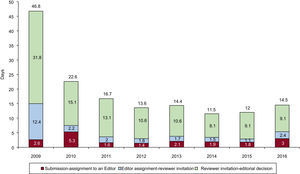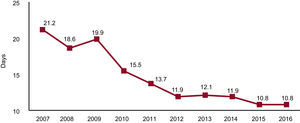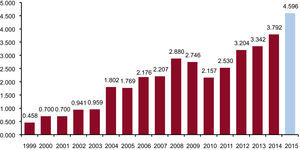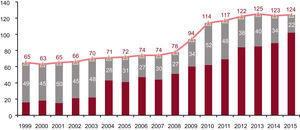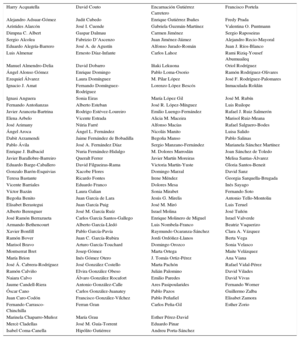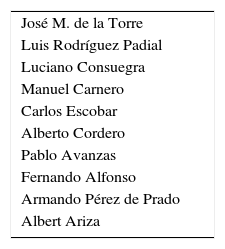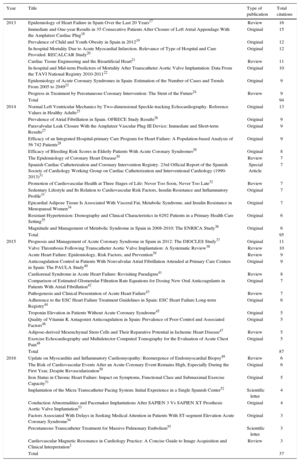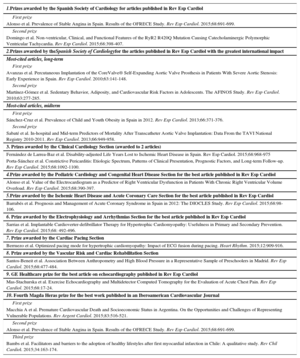As customary, in the present Editor's Page, the editorial team appraise the previous year of Revista Española de Cardiología (Rev Esp Cardiol), reporting its overall situation and its future direction. The highlight for 2016 was the excellent impact factor results. With a record high of 4.596, this impact factor places our journal in the first quartile of cardiovascular journals. Although excellent news, the increase in impact factor should be interpreted with caution, because bibliometric indices are in constant flux. Nonetheless, the new impact factor provides a clear opportunity to consolidate our position as the leading Spanish-language and bilingual cardiovascular journal. These pages also serve to thank and congratulate both the authors of all of the work published in the journal and the previous editorial teams, who undoubtedly deserve the credit for this bibliometric success.
CHANGES TO THE PUBLICATIONS OF REVISTA ESPAÑOLA DE CARDIOLOGÍAAs is already well known by readers, Rev Esp Cardiol publishes a monthly issue and a variable number of annual supplements; the standard articles include “Original Articles”, “Editorials”, “Scientific Letters”, “Letters to the Editor”, and “Special Articles”, as well as other article types such as “ECG Contest” and “Images in Cardiology”.
The total numbers of articles published by Rev Esp Cardiol in recent years are shown in Figure 1. Compared with the previous year, the number of articles published in 2016 increased by more than 10%. This increase is unsurprising because the total number of manuscripts received rose by 20% vs 2015 (Figure 2), representing the largest increase of the last 10 years. This increment also affected original articles, with 10% more articles being submitted in 2016 than in 2015. The final acceptance rate for 2016 is expected to be around 15%-17%, with a number of manuscripts still pending decision at the time of publishing this article (Figure 3).
Two types of review articles were published until 2016: 4 to 5 review articles based around a certain topic, belonging to the “Focus” series, and 7 to 10 articles reviewing a specific knowledge area, belonging to the “Update” series. Thus, in 2016, 8 articles were published in the “Update: Cardiac Imaging” series.1–8 For the coming and subsequent years, the new editorial team has decided to replace the “Update” series with a similar number of reviews on diverse topics deemed of interest to our readers. Some of these reviews will be individual, whereas others will be grouped around a specific topic; this format will thus be similar to that of the “Focus” series. We believe that this strategy has 2 benefits. First, it allows for greater flexibility in the selection of topics of interest and expert authors. Second, it will broaden the range of review topics available, which will probably appeal to a wider variety of readers. A drawback is that we will lose the accredited course of the “Update” series. However, because we believe that the range of courses offered by the Spanish Society of Cardiology (SEC) is quite wide and varied, the previously undeniable added teaching value of the “Update” series has diminished in recent years.
Another change in the format of the publications affects the “Topical Issues” series. Coordinated by different scientific sections of the SEC, these publications summarize and highlight the most important developments of the previous year in each specialty area. Although the series has clear educational value, its publication in the form of special articles reduces the space available for other article types, such as original articles and reviews.
For example, 6 articles were published in the 2016 series.9–14 Due to the limited space in Rev Esp Cardiol and the continual and growing demand for the publication of original articles, we believe that they should take precedence over the publication of “Topical Issues” in the form of special articles. However, we are aware of the usefulness and value of the continued publication by Rev Esp Cardiol of news on the scientific developments in each area. To try to reconcile these 2 aspects—to both increase the space available for original articles and maintain the information of the “Topical Issues”—, from 2017, these articles will be published in the form of scientific letters, a format that we believe to be more suitable for the aims of the series and, possibly, easier to read.
In addition, 2 new sections have been introduced. In the first, called “Atrium”, the Editor-in-chief will summarize the contents and highlight the salient message and main strengths and weaknesses of the original articles published in the issue. We believe that these articles will be of interest to readers wanting an overview of the contents of each issue and will help them to select the most interesting items. The second section, called “Viaje al corazón de las palabras” (Into the heart of terminology), made its debut in January of this year and comes from the hand of Fernando A. Navarro, a member of the Advisory Board of Rev Esp Cardiol. These Spanish language-only articles, taking the form of brief and light-hearted notes, shed light on the etymology and distinguishing features of medical language and offer help on frequent doubts and hard-to-translate terms.
Two editorial changes have been made to original articles. First, the limit on the number of authors has been removed because multicenter studies with multiple authors meeting the authorship criteria15 are now more common. Second, these articles now include a “Key points” box, which permits authors to summarize what is already known about the topic and, more importantly, what their work adds. We consider these key points, already adopted by numerous biomedical journals, to be a useful exercise benefiting both the readers and the authors themselves.
Finally, changes have been made to the processing of the consensus documents that are periodically prepared by working groups from different fields of knowledge: the main characteristics of the documents now need to be presented to the Executive Committee of the SEC so that it can evaluate their priority as it pertains to the society. Because Rev Esp Cardiol is the official journal of the SEC, we believe that the Executive Committee should play an important role in setting the organizational priority of these documents. Once this has been decided by the Executive Committee, the document will follow the standard editorial process.
Regarding the digital version of the journal and social media, the strategy during 2016 has been to strive for a greater presence and increased proactivity. Thus, it was considered prudent to enlist the technical advice and work of a professional expert in the area, Dr José Juan Gómez de Diego, who was recruited at the start of 2016. On the one hand, our strategy has been to augment the elements of the digital version of our journal, such as the website, in particular, the blog, and the “ECG Contest”. The results have been highly positive, as shown by the increased number of visitors to our website: from 2014 to April 2016 onward, average monthly visits to the Rev Esp Cardiol blog rose from 1800 to more than 7000. This trend has been repeated for the presence of Rev Esp Cardiol in social media, where a marked increase was seen vs the previous year (Figure 4). Among the most significant changes, in January 2016 the “ECG Contest” ceased to be a closed section that only accepted invited articles and was opened to the public to allow unsolicited contributions. The format was also modified to include a question with 4 possible answers that readers can select in the electronic version of the article. Another novelty is the launch of a Facebook page for Rev Esp Cardiol. Curiously, Facebook had already helped to funnel traffic to our website before Rev Esp Cardiol even had an official account on the network (Figure 4). As expected, the official Facebook page, launched in March 2016, has notably increased the dissemination of our contents.
CHANGES IN EDITORIAL PROCESSESThe trend in editorial processing times from manuscript receipt to the final decision is shown in Figure 5. In the last year, the average processing time slightly increased–by 2.5 days–specifically in the first 2 phases. There were 2 reasons for this increase. First, the entirely expected and necessary learning curve of the new editorial team members, who have had to adapt to a somewhat complicated process. Second, the continued increase in the number of submitted manuscripts (Figure 1), which has led to a certain work overload. Given this increased workload, the number of staff in the editorial office was increased midway through the year, principally to lighten the load related to manuscript processing tasks. Although we hope that the 2017 times will approach those of 2014 and 2015, the general mean editorial processing time of Rev Esp Cardiol is nonetheless still one of the best among journals in its field (14.5 days), according to what is stated on their websites. What has not changed from previous years is the excellent work performed by our tireless reviewers (Figure 6). We would like to sincerely thank here reviewers who collaborate with us even though they are not part of our Editorial Committee (Table 1). In addition, the elite reviewers of 2016 also deserve special mention (Table 2).
List of Collaborators 2016
| Harry Acquatella | David Couto | Encarnación Gutiérrez Carretero | Francisco Portela |
| Alejandro Adsuar-Gómez | Judit Cubedo | Enrique Gutiérrez Ibañes | Fredy Prada |
| Arístides Alarcón | José I. Cuende | Gabriela Guzmán-Martínez | Valentina O. Puntmann |
| Dimpna C. Albert | Gaspar Dalmau | Carmen Jiménez | Sergio Raposeiras |
| Sergio Alcolea | Fabrizio D’Ascenzo | Juan Jiménez-Jáimez | Alejandro Recio-Mayoral |
| Eduardo Alegría-Barrero | José A. de Agustín | Alfonso Jurado-Román | Juan J. Ríos-Blanco |
| Luis Almenar | Ernesto Díaz-Infante | Carlos Lahoz | Rami Riziq-Yousef Abumuaileq |
| Manuel Almendro-Delia | David Dobarro | Iñaki Lekuona | Oriol Rodríguez |
| Ángel Alonso Gómez | Enrique Domingo | Pablo Loma-Osorio | Ramón Rodríguez-Olivares |
| Ezequiel Álvarez | Laura Domínguez | M. Pilar López | José F. Rodríguez-Palomares |
| Ignacio J. Amat | Fernando Domínguez-Rodríguez | Lorenzo López Bescós | Inmaculada Roldán |
| Ignasi Anguera | Sonia Eiras | María López Gil | José M. Rubín |
| Fernando Antoñanzas | Alberto Esteban | José R. López-Mínguez | Luis Ruilope |
| Javier Aranceta-Bartrina | Rodrigo Estévez-Loureiro | Emilio Luengo-Fernández | Rafael J. Ruiz Salmerón |
| Elena Arbelo | Vicente Estrada | Alicia M. Maceira | Marisol Ruiz-Meana |
| José Arimany | Núria Farré | Alfonso Macías | Rafael Salguero-Bodes |
| Ángel Aroca | Ángel L. Fernández | Nicolás Manito | Luisa Salido |
| Dabit Arzamendi | Jaime Fernández de Bobadilla | Begoña Manso | Pablo Salinas |
| Pablo Ávila | José A. Fernández Díaz | Sergio Manzano-Fernández | Marianela Sánchez Martínez |
| Enrique J. Balbacid | Nuria Fernández-Hidalgo | M. Dolores Marrodán | Joan Sánchez de Toledo |
| Javier Barallobre-Barreiro | Queralt Ferrer | Javier Martín Moreiras | Melisa Santas-Álvarez |
| Eduardo Barge-Caballero | David Filgueiras-Rama | Victoria Martín-Yuste | Gloria Santos-Beneit |
| Gonzalo Barón-Esquivias | Xacobe Flores | Domingo Marzal | David Sanz |
| Teresa Bastante | Ricardo Fontes | Irene Méndez | Georgia Sarquella-Brugada |
| Vicente Barriales | Eduardo Franco | Dolores Mesa | Inés Sayago |
| Víctor Bazán | Laura Galian | Sonia Mirabet | Fernando Soto |
| Begoña Benito | Juan García de Lara | Jesús G. Mirelis | Antonio Tello-Montoliu |
| Elisabet Berastegui | Juan García Puig | José M. Miró | Luis Teruel |
| Alberto Berenguer | José M. García Ruíz | Israel Molina | José Tuñón |
| José Ramón Berrazueta | Carlos García Santos-Gallego | Enrique Molinero de Miguel | Israel Valverde |
| Armando Bethencourt | Alberto García-Lledó | Luis Nombela-Franco | Beatriz Vaquerizo |
| Xavier Bonfill | Pablo García-Pavía | Raymundo Ocaranza-Sánchez | Clara A. Vázquez |
| Ramón Bover | Juan C. García-Rubira | Jordi Ordóñez-Llanos | Berta Vega |
| Marisol Bravo | Arturo García-Touchard | Domingo Orozco | Sonia Velasco |
| Montserrat Bret | Josep Gómez | Marta Ortega | Maite Velázquez |
| María Brion | Inés Gómez Otero | J. Tomás Ortiz-Pérez | Ana Viana |
| José Á. Cabrera-Rodríguez | José González Costello | Marta Pachón | Rafael Vidal-Pérez |
| Ramón Calviño | Elvira González Obeso | Julián Palomino | David Vilades |
| Naiara Calvo | Álvaro González Rocafort | Emilio Paredes | David Vivas |
| Jaume Candell-Riera | Antonio González-Calle | Ares Pasipoularides | Fernando Worner |
| Óscar Cano | Carlos González-Juanatey | Pablo Pazos | Guillermo Zalba |
| Juan Caro-Codón | Francisco González-Vílchez | Pablo Peñafiel | Elisabet Zamora |
| Fernando Carrasco-Chinchilla | Ferran Gran | Carlos Peña-Gil | Esther Zorio |
| Marinela Chaparro-Muñoz | María Grau | Esther Pérez-David | |
| Mercè Cladellas | José M. Guía-Torrent | Eduardo Pinar | |
| Isabel Coma-Canella | Hipólito Gutiérrez | Andreu Porta-Sánchez |
The situation is different for the time from manuscript acceptance to online publication. This interval, which depends directly on our publisher, was an average of 120 to 140 days in 2015 and the first half of 2016, representing a significantly longer delay than that reported by other cardiovascular journals with similar impact factors. Bilingual publication of Rev Esp Cardiol complicates the editing process, delaying publication and possibly even diminishing the scientific visibility of the journal. Thus, during 2016, a special effort was made to reduce this interval via the implementation of a new process. This new process represents a paradigm shift because, instead of the parallel processing of the 2 versions (Spanish and English), the version in the original submission language is rapidly edited and published, becoming available ahead of print in 7 to 8 weeks and thus being included in the main bibliographic databases (eg, ScienceDirect). If the original submission language is English, the article additionally becomes available as soon as possible on PubMed. The translated version is published with an additional delay of 8 to 10 weeks. We believe that this strategy will improve the visibility of Rev Esp Cardiol and of authors publishing in our journal.
Finally, as already indicated,16 the first course for Rev Esp Cardiol reviewers took place in February 2017. Aimed at professionals who act as peer reviewers for our journal, its objective was to minimize inter reviewer variability.
THE CURRENT IMPACT FACTOR SITUATION AND THE BIBLIOMETRIC TRENDAs already mentioned, one of the most positive developments of 2016 was the highly significant increase in the impact factor for 2015, which now places Rev Esp Cardiol in the first quartile of journals in the field of cardiovascular medicine. As is already widely known, the higher the number of citations achieved by a journal and the fewer the number of citable articles—basically original articles and reviews—published in the previous 2 years, the higher the impact factor. Figure 7 shows the bibliometric trend of Rev Esp Cardiol, which was placed in the first quartile of cardiovascular journals in the 2015 edition of the Journal Citation Reports, ranking 22 out of a total of 124 journals (Figure 8).
An interesting exercise is to determine what types of publications have had the highest scientific dissemination and visibility in recent years. The publications of 2013 and 2014 influenced the impact factor for 2015 while those published in 2014 and 2015 will influence the impact factor for 2016; in addition, those published in 2016 affect the immediacy index, a reflection of the speed of the scientific visibility of a publication because it depends on the citations received in the same year as its publication. This information is shown in Table 3, extracted from the Web of Science of the Institute for Scientific Information56 at the start of 2017. The articles generating the most citations in 2016 have been selected according to the following criteria: from 2013, articles with more than 6 citations; from 2014, those with more than 5; from 2015, those with more than 4; and from 2016, those with 3 or more.
Original Articles Published in Revista Española de Cardiología in 2013, 2014, 2015, and 2016 Receiving the Most Citations in 2016*
| Year | Title | Type of publication | Total citations |
|---|---|---|---|
| 2013 | Epidemiology of Heart Failure in Spain Over the Last 20 Years17 | Review | 16 |
| Immediate and One-year Results in 35 Consecutive Patients After Closure of Left Atrial Appendage With the Amplatzer Cardiac Plug18 | Original | 15 | |
| Prevalence of Child and Youth Obesity in Spain in 201219 | Original | 12 | |
| In-hospital Mortality Due to Acute Myocardial Infarction. Relevance of Type of Hospital and Care Provided. RECALCAR Study20 | Original | 12 | |
| Cardiac Tissue Engineering and the Bioartificial Heart21 | Review | 11 | |
| In-hospital and Mid-term Predictors of Mortality After Transcatheter Aortic Valve Implantation: Data From the TAVI National Registry 2010-201122 | Original | 10 | |
| Epidemiology of Acute Coronary Syndromes in Spain: Estimation of the Number of Cases and Trends From 2005 to 204923 | Original | 9 | |
| Progress in Treatment by Percutaneous Coronary Intervention: The Stent of the Future24 | Review | 9 | |
| Total | 94 | ||
| 2014 | Normal Left Ventricular Mechanics by Two-dimensional Speckle-tracking Echocardiography. Reference Values in Healthy Adults25 | Original | 13 |
| Prevalence of Atrial Fibrillation in Spain. OFRECE Study Results26 | Original | 9 | |
| Paravalvular Leak Closure With the Amplatzer Vascular Plug III Device: Immediate and Short-term Results27 | Original | 9 | |
| Efficacy of an Integrated Hospital-primary Care Program for Heart Failure: A Population-based Analysis of 56 742 Patients28 | Original | 9 | |
| Efficacy of Bleeding Risk Scores in Elderly Patients With Acute Coronary Syndromes29 | Original | 8 | |
| The Epidemiology of Coronary Heart Disease30 | Review | 7 | |
| Spanish Cardiac Catheterization and Coronary Intervention Registry. 23rd Official Report of the Spanish Society of Cardiology Working Group on Cardiac Catheterization and Interventional Cardiology (1990-2013)31 | Special Article | 7 | |
| Promotion of Cardiovascular Health at Three Stages of Life: Never Too Soon, Never Too Late32 | Review | 7 | |
| Sedentary Lifestyle and Its Relation to Cardiovascular Risk Factors, Insulin Resistance and Inflammatory Profile33 | Original | 7 | |
| Epicardial Adipose Tissue Is Associated With Visceral Fat, Metabolic Syndrome, and Insulin Resistance in Menopausal Women34 | Original | 7 | |
| Resistant Hypertension: Demography and Clinical Characteristics in 6292 Patients in a Primary Health Care Setting35 | Original | 6 | |
| Magnitude and Management of Metabolic Syndrome in Spain in 2008-2010: The ENRICA Study36 | Original | 6 | |
| Total | 95 | ||
| 2015 | Prognosis and Management of Acute Coronary Syndrome in Spain in 2012: The DIOCLES Study37 | Original | 11 |
| Valve Thrombosis Following Transcatheter Aortic Valve Implantation: A Systematic Review38 | Review | 10 | |
| Acute Heart Failure: Epidemiology, Risk Factors, and Prevention39 | Review | 9 | |
| Anticoagulation Control in Patients With Nonvalvular Atrial Fibrillation Attended at Primary Care Centers in Spain: The PAULA Study40 | Original | 9 | |
| Cardiorenal Syndrome in Acute Heart Failure: Revisiting Paradigms41 | Review | 8 | |
| Comparison of Estimated Glomerular Filtration Rate Equations for Dosing New Oral Anticoagulants in Patients With Atrial Fibrillation42 | Original | 7 | |
| Pathogenesis and Clinical Presentation of Acute Heart Failure43 | Review | 7 | |
| Adherence to the ESC Heart Failure Treatment Guidelines in Spain: ESC Heart Failure Long-term Registry44 | Original | 6 | |
| Troponin Elevation in Patients Without Acute Coronary Syndrome45 | Original | 5 | |
| Quality of Vitamin K Antagonist Anticoagulation in Spain: Prevalence of Poor Control and Associated Factors46 | Original | 5 | |
| Adipose-derived Mesenchymal Stem Cells and Their Reparative Potential in Ischemic Heart Disease47 | Review | 5 | |
| Exercise Echocardiography and Multidetector Computed Tomography for the Evaluation of Acute Chest Pain48 | Original | 5 | |
| Total | 87 | ||
| 2016 | Update on Myocarditis and Inflammatory Cardiomyopathy: Reemergence of Endomyocardial Biopsy49 | Review | 6 |
| The Risk of Cardiovascular Events After an Acute Coronary Event Remains High, Especially During the First Year, Despite Revascularization50 | Original | 6 | |
| Iron Status in Chronic Heart Failure: Impact on Symptoms, Functional Class and Submaximal Exercise Capacity51 | Original | 5 | |
| Implantation of the Micra Transcatheter Pacing System: Initial Experience in a Single Spanish Center52 | Scientific letter | 4 | |
| Conduction Abnormalities and Pacemaker Implantations After SAPIEN 3 Vs SAPIEN XT Prosthesis Aortic Valve Implantation53 | Original | 4 | |
| Factors Associated With Delays in Seeking Medical Attention in Patients With ST-segment Elevation Acute Coronary Syndrome54 | Original | 3 | |
| Percutaneous Transcatheter Treatment for Massive Pulmonary Embolism55 | Scientific letter | 3 | |
| Cardiovascular Magnetic Resonance in Cardiology Practice: A Concise Guide to Image Acquisition and Clinical Interpretation2 | Review | 3 | |
| Total | 37 |
The most common type of publication is the original article, although also represented are reviews and scientific letters. We would like to warmly congratulate all the authors of these articles. Finally, we would also like to mention and congratulate the authors of the publications that received awards from the SEC for their scientific impact and quality (Table 4). As already discussed at the beginning of this article, original articles are a priority for this editorial team. The value of this strategy is confirmed by the excellent results in terms of scientific visibility and analysis of the type of article most contributing to this visibility.
Articles Receiving an Award From the Spanish Society of Cardiology in 2016
| 1.Prizes awarded by the Spanish Society of Cardiology for articles published in Rev Esp Cardiol |
|---|
| First prize |
| Alonso et al. Prevalence of Stable Angina in Spain. Results of the OFRECE Study. Rev Esp Cardiol. 2015;68:691-699. |
| Second prize |
| Domingo et al. Non-ventricular, Clinical, and Functional Features of the RyR2 R420Q Mutation Causing Catecholaminergic Polymorphic Ventricular Tachycardia. Rev Esp Cardiol. 2015;68:398-407. |
| 2.Prizes awarded by theSpanish Society of Cardiologyfor the articles published in Rev Esp Cardiol with the greatest international impact |
| Most-cited articles, long-term |
| First prize |
| Avanzas et al. Percutaneous Implantation of the CoreValve® Self-Expanding Aortic Valve Prosthesis in Patients With Severe Aortic Stenosis: Early Experience in Spain. Rev Esp Cardiol. 2010;63:141-148. |
| Second prize |
| Martínez-Gómez et al. Sedentary Behavior, Adiposity, and Cardiovascular Risk Factors in Adolescents. The AFINOS Study. Rev Esp Cardiol. 2010;63:277-285. |
| Most-cited articles, midterm |
| First prize |
| Sánchez-Cruz et al. Prevalence of Child and Youth Obesity in Spain in 2012. Rev Esp Cardiol. 2013;66:371-376. |
| Second prize |
| Sabaté et al. In-hospital and Mid-term Predictors of Mortality After Transcatheter Aortic Valve Implantation: Data From the TAVI National Registry 2010-2011. Rev Esp Cardiol. 2013;66:949-958. |
| 3. Prizes awarded by the Clinical Cardiology Section (awarded to 2 articles) |
| Fernández de Larrea-Baz et al. Disability-adjusted Life Years Lost to Ischemic Heart Disease in Spain. Rev Esp Cardiol. 2015;68:968-975 |
| Porta-Sánchez et al. Constrictive Pericarditis: Etiologic Spectrum, Patterns of Clinical Presentation, Prognostic Factors, and Long-term Follow-up. Rev Esp Cardiol. 2015;68:1092-1100. |
| 4.Prize awarded by the Pediatric Cardiology and Congenital Heart Disease Section for the best article published in Rev Esp Cardiol |
| Alonso et al. Value of the Electrocardiogram as a Predictor of Right Ventricular Dysfunction in Patients With Chronic Right Ventricular Volume Overload. Rev Esp Cardiol. 2015;68:390-397. |
| 5.Prize awarded by the Ischemic Heart Disease and Acute Coronary Care Section for the best article published in Rev Esp Cardiol |
| Barrabés et al. Prognosis and Management of Acute Coronary Syndrome in Spain in 2012: The DIOCLES Study. Rev Esp Cardiol. 2015;68:98-106. |
| 6. Prize awarded by the Electrophysiology and Arrhythmias Section for the best article published in Rev Esp Cardiol |
| Sarrias et al. Implantable Cardioverter-defibrillator Therapy for Hypertrophic Cardiomyopathy: Usefulness in Primary and Secondary Prevention. Rev Esp Cardiol. 2015;68: 492-496. |
| 7. Prize awarded by the Cardiac Pacing Section |
| Berruezo et al. Optimized pacing mode for hypertrophic cardiomyopathy: Impact of ECG fusion during pacing. Heart Rhythm. 2015;12:909-916. |
| 8. Prize awarded by the Vascular Risk and Cardiac Rehabilitation Section |
| Santos-Beneit et al. Association Between Anthropometry and High Blood Pressure in a Representative Sample of Preschoolers in Madrid. Rev Esp Cardiol. 2015;68:477-484. |
| 9. GE Healthcare prize for the best article on echocardiography published in Rev Esp Cardiol |
| Mas-Stachurska et al. Exercise Echocardiography and Multidetector Computed Tomography for the Evaluation of Acute Chest Pain. Rev Esp Cardiol. 2015;68:17-24. |
| 10. Fourth Magda Heras prize for the best work published in an Iberoamerican Cardiovascular Journal |
| First prize |
| Macchia A et al. Premature Cardiovascular Death and Socioeconomic Status in Argentina. On the Opportunities and Challenges of Representing Vulnerable Populations. Rev Argent Cardiol. 2015;83:516-521. |
| Second prize |
| Alonso et al. Prevalence of Stable Angina in Spain. Results of the OFRECE Study. Rev Esp Cardiol. 2015;68:691-699. |
| Third prize |
| Bambs et al. Facilitators and barriers to the adoption of healthy lifestyles after first myocardial infarction in Chile: A qualitative study. Rev Chil Cardiol. 2015;34:163-174. |
Finally, we are hugely pleased to dedicate some words to congratulate the Editorial Director of Rev Esp Cardiol, Iria del Río, for her recent appointment to the council of the Committee on Publication Ethics (COPE).57 As our readers probably know, this institution is a prestigious international forum of editors and publishers of academic journals that addresses and discusses all aspects related to ethical matters affecting publications. Its mission is to promote integrity in the field of academic publication. To help readers to properly gauge the importance of this appointment, suffice to say that, of the more than 11 000 members of COPE, only 27 are current council members. The decision was preceded by an exhaustive selection process and we are enormously proud that Rev Esp Cardiol has managed to achieve the first Spanish representative on the Council. We send our thanks and congratulations to Iria del Río for this excellent news, which will undoubtedly help to guide the development of Rev Esp Cardiol and inform its policies.
CONCLUSIONSRev Esp Cardiol is the official scientific publication of the SEC and its medium of institutional expression. During the previous year, the most important development has been a major change in the editorial process, which has significantly reduced publication times. Other changes include a modification in the format of some publications and the review article series, the introduction of 2 new sections, and new support for the digital version and social media dissemination. Rev Esp Cardiol has achieved a growing impact in terms of scientific visibility and is currently placed in the first quartile of its specialty, leading us to look to the future with optimism.
CONFLICTS OF INTERESTSNone declared.




